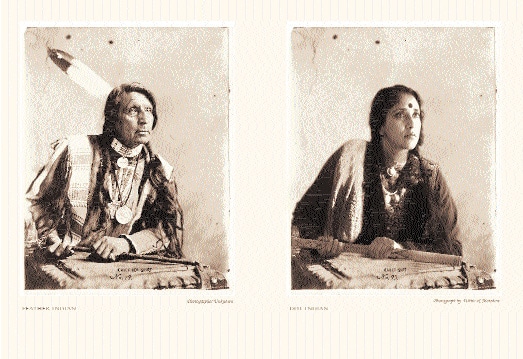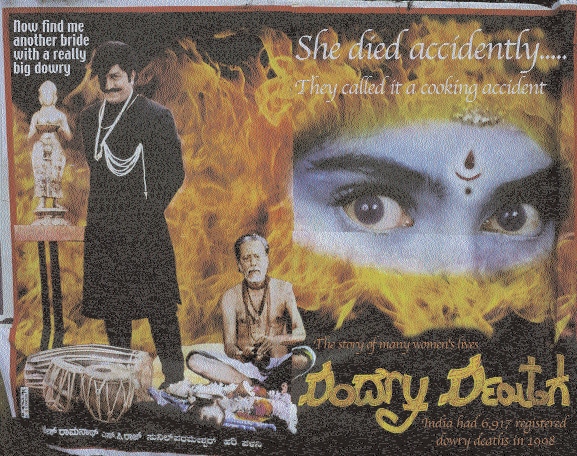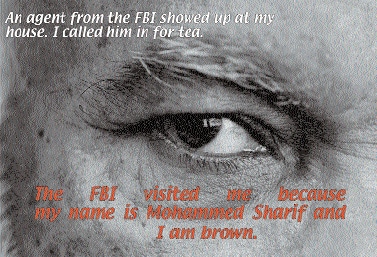Annu Matthew
pavel banka's interview with annu matthew
Annu, we met for the first time in Fotofest Houston in 1998. Your work was already impressive to me by that time. I was pleased to see how quite conceptual work could also be beautifully done – I mean you were taking care not only about the meaning but each of your double sitting of Indian From India was perfectly elaborated, the prints were carefully toned to match original Edward Curtis photographs.
Looking at your later work, you seems to like not only photography as a means of expression but also as a medium, which you like to touch and to finish as a single piece of a precise craft. How do you see photography as a medium, and with a conceptual idea and the final picture?
You are right, there is something about photography that has always appealed to me and a medium that I feel I can communicate through. I like photography’s connection with reality and the challenge of having to create the work from the illusion of reality. I am interested in getting ideas or concepts across and the craftsmanship is always equally important. It is my point of view that if I just want to get the idea across, I can write an article or if the work is just about aesthetics, I shouldn’t stretch it to fit a conceptual idea. It is important for me for the two to meld together and I am glad that you perceived that.
Reading your statements and looking on the images I first feel a theme of identity and then one of nostalgia as main motives of your work. What do you think about this?
My work primarily draws on my personal experiences of having lived in three cultures (England, India and America) and is about belonging and not belonging to all three. So my work has always been about my experience and identity but the ideas also address broader issues. I would agree that my black and white work Memories of India has hints of nostalgia. I think this comes from earlier regret of not belonging to any one country. But my later work An Indian from India loses some of that nostalgia as I have come to enjoy and celebrate my trans-national status.
Your latest work Backlash in the Wake of 9/11 I would even term ”political art“, but of course it is not only that. Would you agree?
All my work except Memories of India has had political overtones and has been about being the ”other“ whether in England, India or America. Bollywood Satirized is a critical look at my experience growing up as a woman in India, An Indian from India looks at being the other in American society. In the project Backlash in the Wake of 9/11, I wanted to give a voice to people who look different from what the assumption of an American looks like. As a South Asian immigrant, I have been disturbed by the hate crimes after 9/11 directed at Americans who are mistakenly blamed for the horrible crimes in New York, Washington and Pennsylvania. Sadly the targeting of immigrants is nothing new. Italian-Americans in the early 20th century, the Irish, the Japanese-American internment during World War II are a few examples.
I decided to photograph people who were indirect victims of violence since 9/11 and live in a new reality. In this new reality, some of us need to be conscious of the way we look and how others perceive us and our names, as these identifiers have taken on new and unintended meanings. As the project evolved, many people said that they did not want their faces shown in connection with their stories.
To accommodate this fear, I decided to use an icon that was unique to the individual yet unrecognizable to a viewer, the fingerprint. The fingerprint can be used to identify a person and is an important part of the identification process for both immigrants and for criminals. It is a trace of a person and yet from it, the racial identity of the individual is not recognizable. Ironically, one of the first uses of the fingerprint as a form of identification was by the British in India. Going back to aesthetics, there is something beautiful yet simple and powerful about a white fingerprint against a black background. The fact that some of the people didn’t want to be recognized implies a lot.
As I mentioned before, those pictures are so perfectly elaborated that I have a feeling you are not only a photographer, that the graphic design of type carefully placed into the images makes them even more unique. The combination of photographic images with mounted writing is quite popular in American photography lately, but your approach is very different from the approach of Barbara Kruger, to name at least the most famous artist using writing and photographs. Your writing is almost ornamental. Am I right when I feel that I see an influence of Indian or Asian art in those pictures?
I would have to say that Barbara Kruger and Nancy Burson have been influences. I think Krueger’s use of visuals is very clever and different from the almost ”precious“ way that I use mine. If the use of writing in my pieces is ornamental, it may be a reflection of my cultural influences and is not conscious. In An Indian from India, I was trying to mimic the Curtis photogravure portfolio and the text in this portfolio. In Bollywood Satirized, I was imitating the style of text used in the various posters.
Some argue that I am not a photographer but a photo-based artist who uses photography in my work. The photographs are not completely from reality nor completely constructed. Whatever the label given, I think I have chosen my approach to a project depending how well it goes with the concept. The over the top Bollywood posters allow me to use humor and satire to ”gently“ get some strong messages and points of view across. An Indian from India again uses humor to ask the viewer to rethink preconceived notions.
Is there anything ”next“ in your work, that you wouldn’t mind mentioning now?
I am presently in India (through the American Institute of Indian Studies) for four months, working on a new project titled Viscerally or Virtually Americans.
Viscerally or Virtually Americans is an exploration of the constant fluidity and complex dimensions of the immigrant identity, relevant as we consider the effects of technology and globalization. The work will draw a parallel between the experiences of workers at call centers in India as well as those of immigrants and recent citizens in the US. These call centers receive international phone calls for anything from customer service to technical problem solving. To work in these call centers, Indians study American culture and either neutralize their Indian accents or adopt American ones.
These virtual immigrants become Americans for the workday but remain physically in India. I will compare this virtual immigrant to the experiential and visceral experience of immigrating to America. Identity is typically associated with tangible categorizations i.e. race, ethnicity, gender, class or sexuality. The work will consider a potentially more universal space, the ether where the virtual immigrant resides, and its relation to the visceral experience of a recent immigrant.
I have started interviewing immigrants in America and the virtual immigrants in India. The audio interviews are an important part of the project. Using audio is a different approach for me. It has been fascinating to understand the psychological and sociological effects of immigration. Right now, I visualize the final presentation of the work as a multimedia piece consisting of photos and excerpts of interviews where the photos create a metaphor for the experience. This piece will be coupled with photos that depict that the participants sense of identity as an American and/or as an Indian. The first exhibition of this work is scheduled for September 2006.
http://www.annumatthew.com/Homepage/annu_home.html
#6 The Recycle Image
Archive
- #45 hypertension
- #44 empathy
- #43 collecting
- #42 food
- #41 postdigital photography
- #40 earthlings
- #39 delight, pain
- #38 death, when you think about it
- #37 uneven ground
- #36 new utopias
- #35 living with humans
- #34 archaeology of euphoria
- #33 investigation
- #32 Non-work
- #31 Body
- #30 Eye In The Sky
- #29 Contemplation
- #28 Cultura / Natura
- #27 Cars
- #26 Documentary Strategies
- #25 Popular Music
- #24 Seeing Is Believing
- #23 Artificial Worlds
- #22 Image and Text
- #21 On Photography
- #20 Public Art
- #19 Film
- #18 80'
- #17 Amateur Photography
- #16 Photography and Painting
- #15 Prague
- #14 Commerce
- #13 Family
- #12 Reconstruction
- #11 Performance
- #10 Eroticon
- #9 Architecture
- #8 Landscape
- #7 New Staged Photography
- #6 The Recycle Image
- #5 Borders Of Documentary
- #4 Intimacy
- #3 Transforming Of Symbol
- #2 Collective Authorship
- #1 Face












